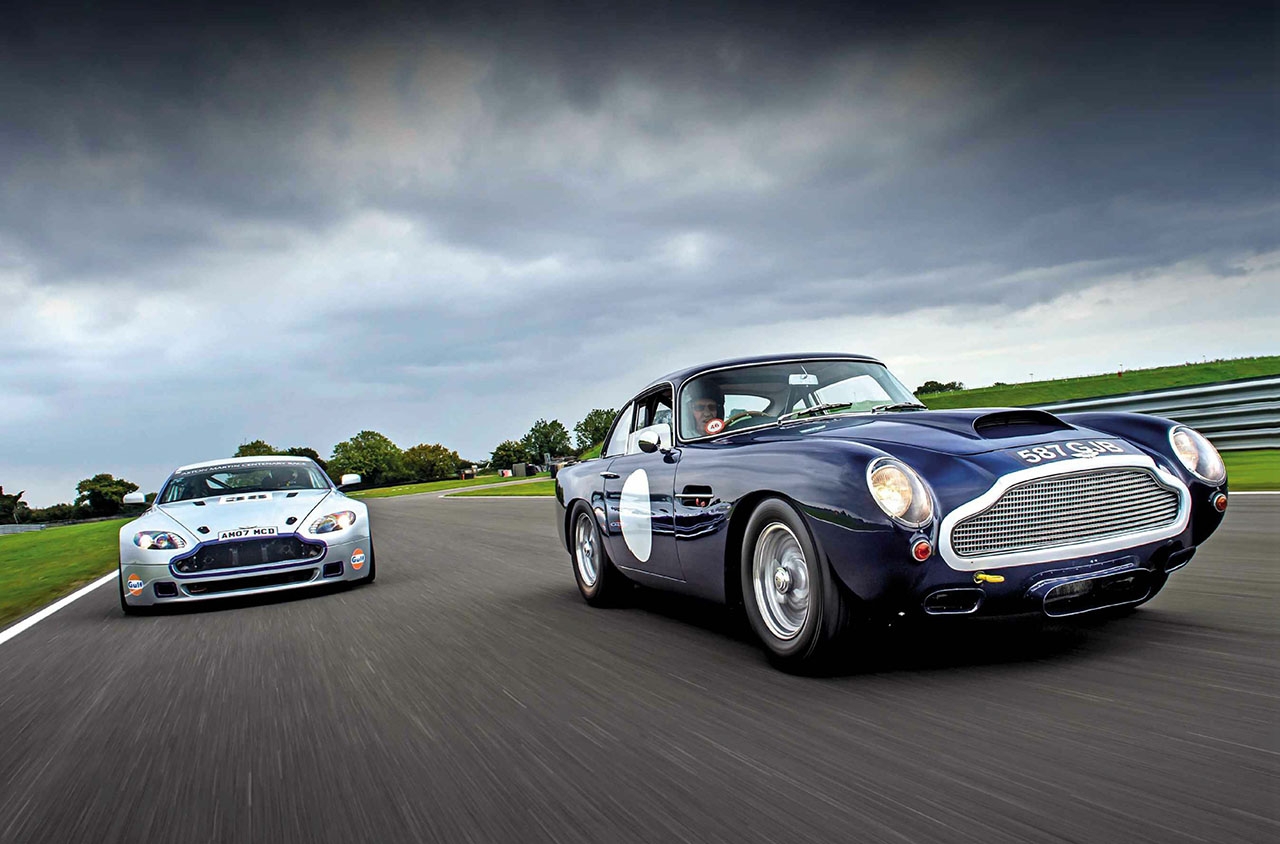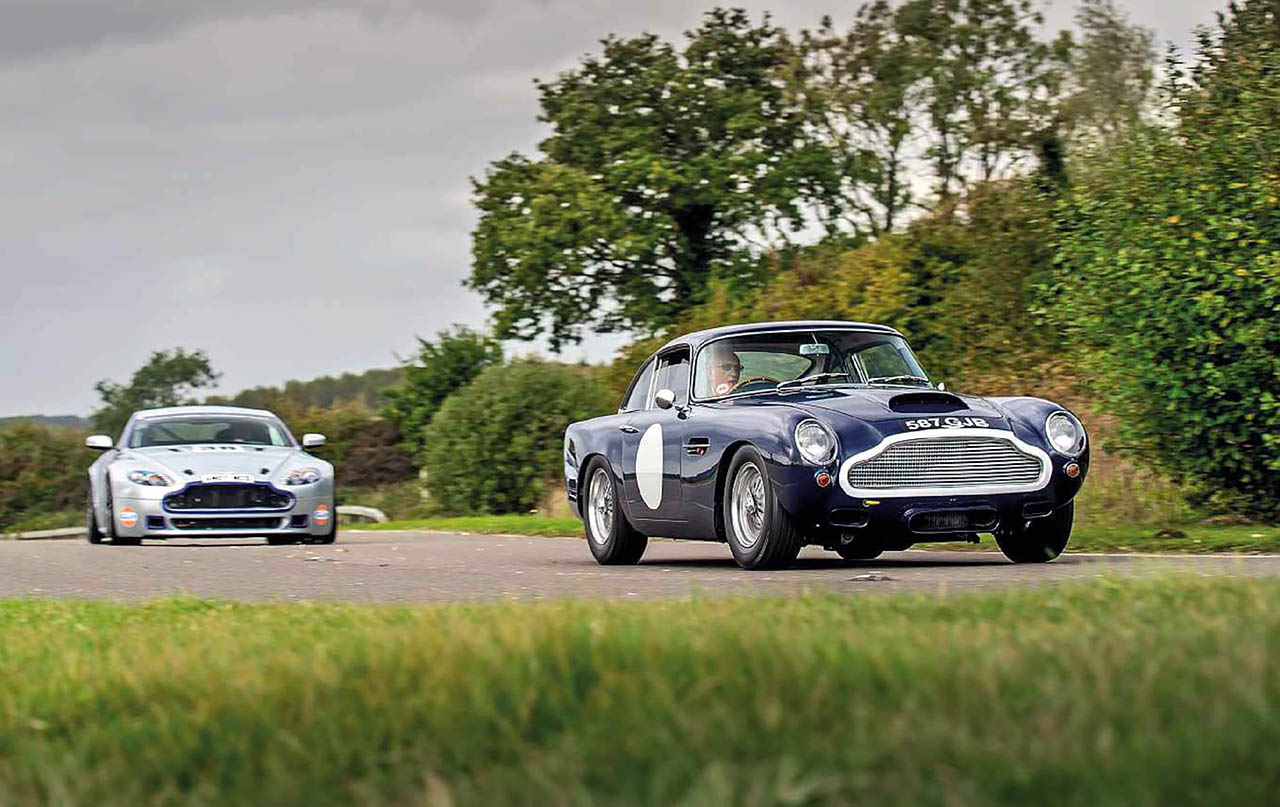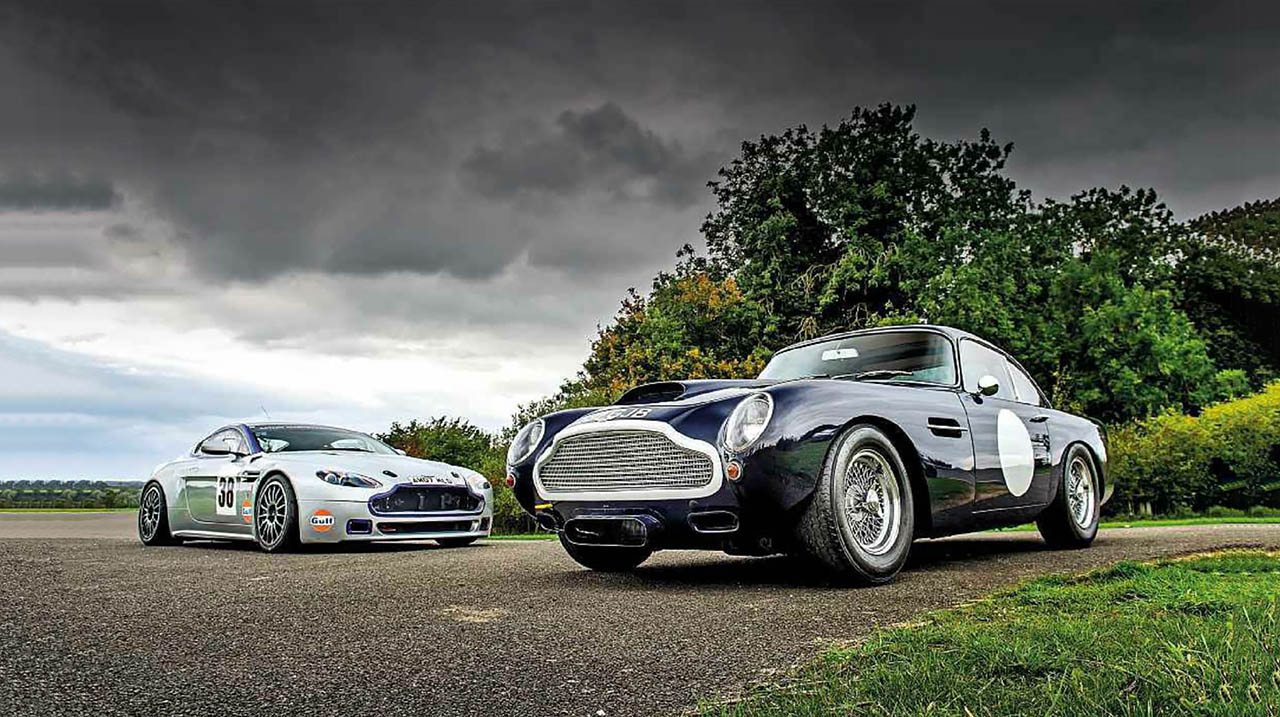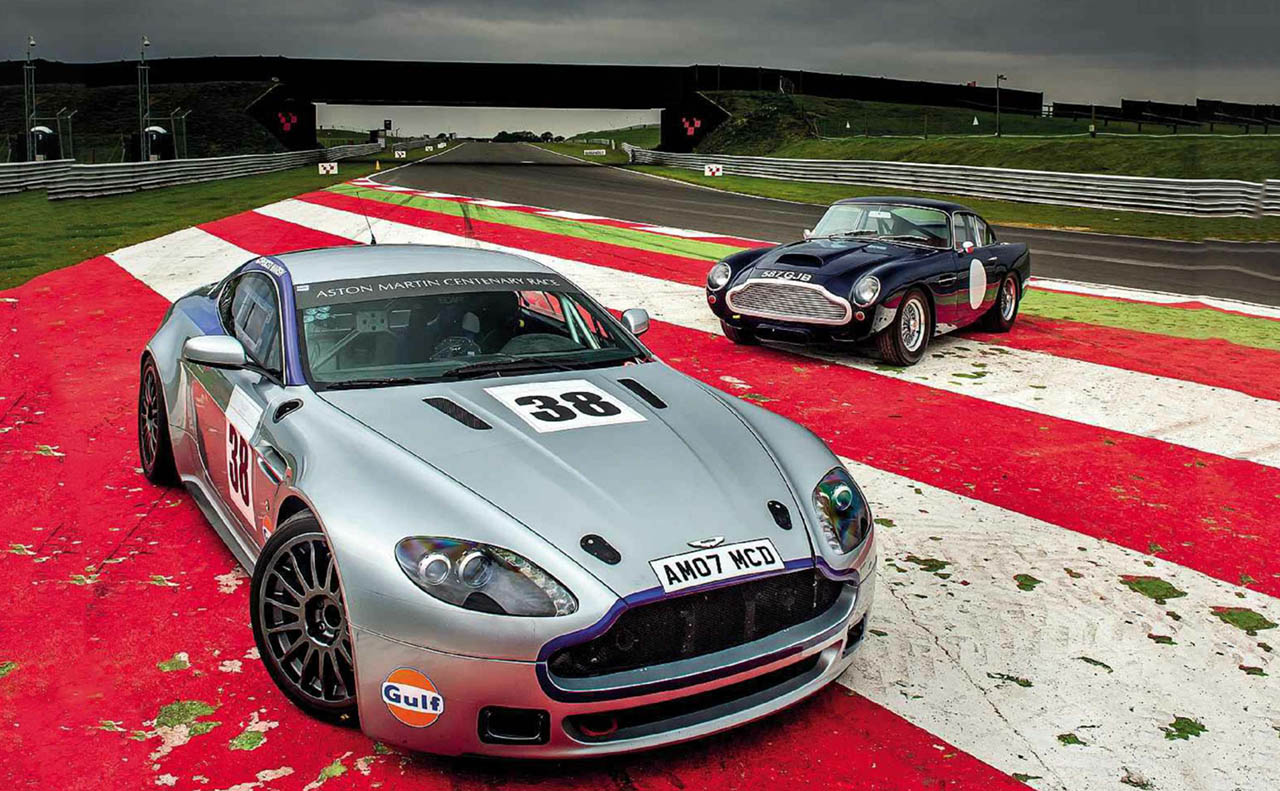
Gentlemen’s racers. A DB4 GT meets its modern equivalent, a V8 Vantage N24, on road and track. Twin test DB4 GT and V8 Vantage N24. The DB4 GT was the classic gentleman’s racer, at home on road or track. Might a V8 Vantage be its modern equivalent? Words Stephen Archer. Photography Andy Morgan.
Received wisdom says that the days of the classic gentlemen’s racer – that is, a serious competition car that you could drive to a circuit, race flat-out for 20 laps, then drive home again – ended in the early 1960s. Modern racing machines, it’s widely held, are just too tightly focused on their track performance. Try to drive them on the public highway and the rock-hard suspension will shake both car and driver to pieces, while full roll-cages and five-point harnesses make even getting in and out an ordeal. And you can forget any hope of a passenger enjoying the ride – unless they’re ex- SAS. The DB4 GT was surely the last serious Aston that could be both driven on the road and raced with success.

That was certainly my view – until last year, when I saw a V8 Vantage N24 competing in an AMOC Intermarque race wearing road plates. Here was a factory-built race car that could apparently also be used to get the driver to the meeting and home again afterwards. Just like the old days. But just how useable could a modern racer be as a road car, and how would it compare with its famous forebear?
To find out, we’ve come to Snetterton circuit in deepest Norfolk with examples of both – a DB4 GT with illustrious period competition history and a Vantage N24 that recently completed its eighth season of racing. We’ll also be reuniting the GT with one of its original drivers, ‘Gentleman Jack’ Sears. It should be quite a day.
The DB4 GT was not only a very important car for Aston Martin but a true dual-role machine. Each of the 75 DB4 GTs (of which 74 survive) was road-registered, while around ten were built with racing in mind from the outset. Eight of the cars were built as true lightweights, but, even then, their suitability for the road was never compromised.
Roughly half of all GTs have been used at some point in their lives for competition purposes, either on the track or in road rallies. Many are still campaigned; the TT recreation at Goodwood is usually graced with three or four DB4 GTs (plus the odd GT Zagato) and the same applies in the US, where GTs can still be seen on track today. No other Aston since the war has been used so extensively as a road/ racing car. Given the deep-rooted reputation of Aston Martin as a maker of GT cars for gentlemen and the gentleman racer, this is perhaps rather surprising.
However, the spirit of the DB4 GT was very much alive in 2006 when a small team from the Gaydon factory entered a modified V8 Vantage in the Nürburgring 24 Hrs. That V8, nicknamed Rose, looked very much like its road car cousin and was (in race car terms) only mildly modified: stripped-out interior, roll-cage, Perspex sideglass, etc. Rose rumbled around the ’Ring for 24 hours at a very decent pace, finishing 24th overall and 4th in class. It was quite a feat, and Aston Martin has returned to the ’Ring many times since, while the V8 Vantage spawned GT4 and GT3 racing derivatives that have enjoyed many, often very significant successes around the world.

Rose herself was subsequently road-registered and famously appeared in a Top Gear road trip (and in Vantage issue 11, when we drove her back to the ’Ring). She in turn spawned the N24 customer racers, of which 24 were built; 15 at Gaydon and nine at Prodrive (making the N24 three times rarer than a DB4 GT!). Since 2006, these N24s have made many track appearances in the hands of gentlemen racers in various series around the world, including of course at Aston Martin Owners Club race meetings.
The N24 here is owned by the Byrne family and has been raced for eight years with many trophies to its name. The Byrnes’ N24 is also one of the few N24s that have been road-registered, though the process requires little more than the fitting of a handbrake for it to be UK road-legal. Steven Byrne had not been racing long when he bought the car. ‘It seemed like a very practical way of entering quite serious GT racing at a reasonable cost,’ he explains.
‘It also turned out to be a very reliable car to race. ‘I found it quite easy to drive at a decent pace,’ he continues. ‘It never scared me and I never felt that it was hard work, unlike the DB4 Lightweight, which I was told I was not driving fast enough if it didn’t scare me!
The N24 immediately gave me great confidence – which is important when the racing is as close as it is at Aston Martin meetings and when conditions can vary a lot.’
The Snetterton tarmac is beckoning. Time to experience the N24 for ourselves. Entering the driver’s seat via the safety cage, lightweight door propped open, is not a quick or easy task. Once in, the Aston’s primary role as a track car is underlined by the bare footwells and the extra switches for fire extinguisher, pit radio, etc. Starting is instantaneous, the noise not so much greater than in a road car, though the cabin echo adds to the effect; with a passenger on board, an intercom would be essential. Steering, brakes, clutch – all feel similar to those of a regular Vantage road car.
Modern roadgoing V8 Astons always seem to combine great composure with great pace, but this car, its engine uprated from 4.3 to 4.7 litres and some 430bhp, is in another league. It tips the scales at around 1400kg with fluids, so one might expect it to be working hard to hustle its weight around a circuit, but on the contrary: around Snetterton, its vivid acceleration, accompanied by a bestial growl, makes it one of the fastest cars on the track, even in the company of some modern racing Porsches. The ample torque provides the push from the slow corners while the top-end power sees it pile on speed relentlessly: on the Snetterton 300 straight I see 140mph before hitting the brakes.

The six-speed manual ’box has an easy but very precise shift. The E-marked Toyo tyres, road-legal but with minimal tread, need warmth in them, but, once they’re up to temperature, they really allow the brakes to shine: indeed such stopping power would leave bruises were the harness not pulled tight. It hardly seems possible that a car with such modest downforce can be arrested so quickly.
Unsurprisingly, cornering grip is equally impressive, the full-body Recaro race-seat emphasising the side-loads. Roadholding is one thing, but the handling, too, is a delight. There’s virtually no body-roll. Slow in and there’s some understeer, but any corner can be taken at huge pace when the throttle is applied. Crucially, the N24 never feels like it’s going to bite you. The steering is perfectly weighted at all speeds, feedback excellent, and with a low-mounted seat you feel reassuringly close to the heart of the car and to the track. There’s rich communication despite the tightness of the chassis, and any clumsiness or off-line antics simply result in an easily managed slide. And none of this feels like hard work.
In short, the N24’s track performance is stunning. It has abundant Aston quality and character, yet drives like a thoroughbred modern racing car and feels as if it would go forever. Downsides? A somewhat restricted view thanks chiefly to the hefty roll-cage, but that’s the modern way.
And now to step back in time. DB4GT/0124/R was delivered new to Englishman Tommy Sopwith in 1960 for his recently formed Equipe Endeavour racing team. It was the first genuine lightweight DB4 GT and was built in the experimental department at Newport Pagnell rather than on the line. These cars featured extensive use of aluminum in the chassis floors and doors.
Sopwith was the son of Thomas Sopwith, founder of the Sopwith aircraft company and renowned America’s Cup yacht racer. It was to echo the colour scheme of the Sopwith racing yacht that the Aston was finished in the Equipe Endeavour racing colours of Jaguar Indigo Blue with the white edging to the grille aperture added later.
Its first outing was in the hands of Stirling Moss at the 1960 BARC Easter Monday meeting at Goodwood, where it won. Later that year, Sopwith entered the car for Jack Sears at Oulton Park and Brands Hatch, Sears coming home first in both races. After the 1960 season, 0124/R was sold to Ron Fry, and subsequent owners included Steve O’Rourke, the Pink Floyd manager and racer. In 2005 it was acquired by current owner Paul Michaels and subsequently became a Goodwood Revival regular, raced by Richard Attwood and Stuart Graham, though it was retired from competition a few years ago.
It’s an absolute delight to have Jack Sears join us at Snetterton, and he’s clearly pleased as Punch to be reunited with 0124/R, some 55 years on. Indeed when we head out onto the track, he’s so enjoying himself being back behind the wheel that he’s reluctant to relinquish the driver’s seat!
‘I thought back in 1960 that it was a superb car – very powerful and with great handling,’ he tells me. ‘It could be four-wheel-drifted with ease because it had such excellent balance. It was a fast car, too. Stowe corner at Silverstone was a 100mph corner in the Aston.’
Track time is tight, and I’m keen to experience 0124/R for myself. It’s soon very evident that, despite having retired from competition, this is still a very well-sorted car. Peeling oneself from the N24’s body-hugging race-seat to sit on the GT’s Connolly leather-trimmed chair might lead one to suspect that the older Aston will be rather less of a racing car experience. Not so.
It feels smaller, of course, but the fantastic all-round visibility is very welcome. As with the N24, the engine can be felt as well as heard, through both the seat and the wood-rimmed steering wheel. The superb Tadek Marek straight-six feels very strong and endows the GT with a similar sensation of relentless acceleration to the N24.
The brakes are also strong for the period, though they will always be able to do less through skinny Dunlop racing tyres than the N24 can with its cut slicks. The David Brown four-speed gearbox is quite notchy, though never obstinate, and, combined with the generally quite heavy controls, it makes this a car that has to be very consciously driven. It does less of the work for you than the N24. But for all that it is arguably more rewarding to drive – and hugely entertaining. As Jack himself remarks: ‘Cars in those days had to be drifted to be driven quickly, quite unlike today’s cars. They were set up to do that and they did it very well. They were terrific in fast corners!’
So, unless you’re on the straight, the DB4 GT always seems to be at some sort of slip angle, which means braking has to be done before the corners, and they in turn have to be treated as exercises in sensitive but committed throttle control. And yet, despite the short wheelbase, the car has no obvious vices and gives you plenty of warning if you’re getting it wrong or taking too many liberties. That benign nature at the limit of grip is just one attribute that the GT shares with the N24. The main differences are in the chassis and tyres, and also in the effort expended by the driver. After an hour racing the DB4 GT, the driver will know he has been working.
Away from the track – and unsurprisingly – both make extremely exciting road cars and both are capable of eating up miles at a prodigious rate. Even on less-than-billiardtable- like road surfaces, the N24 is by no means as harsh as you might expect, while its engine and drivetrain feel wellsuited to road driving. On uneven surfaces there is some ‘tramlining’ and mild steering kick but nothing that cannot be lived with. On a smooth road it’s just fabulously quick, extremely engaging and rather like a forbidden fruit; can so extreme a car really be allowed on the road? There’s room for a passenger seat, too, though luggage capacity is limited somewhat.
One suspects that in town the N24 will also be a lot easier to live with than the GT with its heavy pedals and spitting Webers. But, then again, the GT scores on compactness and all-round vision. The older car, notably tauter and more agile than a regular DB4, is more obviously at home on the road, though. And with Norfolk forests rushing past the windows, it feels as English as local man Lord Nelson – or Jack Sears for that matter.
It’s been a fascinating comparison. What is clear is that the N24 is every inch the accomplished road-racer that it claims to be and, indeed, the rightful heir to the mantle that previously belonged to the DB4 GT. But the last word should go to Jack Sears. ‘I loved racing the DB4 GT,’ he smiles. ‘It was a magnificent, very well-made motor car.’
With thanks to Jack Sears; Paul Michaels and Hexagon; the Byrne family; Angus Archer of SMART Motorsport; MSVR and all at Snetterton circuit.
Where to watch today’s gentlemen racers
Track Versions of the V8 Vantage are eligible for a number of race series. In the UK, the best place to see them is in the newly renamed Aston Martin GT Challenge, run by the Aston Martin Owners Club.
The AM GT Challenge incorporates classes for everything from standard roadgoing V8 Vantages on E-marked tyres (just the thing for today’s gentleman racer!) right through to N24s and GT4 race cars on Dunlop slicks. If you’d like a taste of GT racing, the Stratton Motor Company also has a number of GT4s for hire.
In a new development for 2016, the series now incorporates the Multi-Marque Challenge, which will allow similar cars from other marques, such as Ferrari and Porsche, to compete against the Astons.
Races will be of 50 minutes’ duration, and each will feature a mandatory pit-stop with an optional driver-change. It should make for a great season’s racing. More details at www.amocracing.org
2016 Aston Martin GT Challenge
April 16 British GT meeting, Brands GP
May 28 British GT meeting, Oulton Park
June 11 British GT meeting, Silverstone GP
July 23 AMOC meeting, including Intermarque and GT Challenge, Snetterton
Aug 13 AMOC meeting, Brands Indy
Oct 1 AMOC meeting, Silverstone National
‘Gentleman Jack’ Sears
Jack sears, born in Northampton in 1930, made his racing debut in 1950 and cut his teeth on a variety or pre-war machines and newer Lister sports cars before gravitating to BMC products: he was the first ever British Saloon Car Champion in 1958, driving an Austin A105 that he bought himself (coming from a comfortable family background, he was able to fund his own racing).
Famously he pipped Tommy Sopwith to the title but a great friendship was formed and, when Sopwith retired from racing at the end of 1959 and formed Equipe Endeavour, he soon offered Jack a drive. The team’s dark blue cars would most often be well-sorted Jaguars, but in 1960 they were joined by the DB4 GT and the car enjoyed considerable success, mostly in Jack’s hands.

Opposite and below. DB4GT/0124/R probably has a few more horses under its bonnet these days, but its propensity for drifting through the faster turns is just as pronounced as it was when Jack Sears battled with D-type Jaguars at Silverstone in 1960.
Jack also enjoyed great success with Healeys, both on the track and in rallies, while in 1963 he won the saloon title for the second time in the rather improbable Ford Galaxy. The same year he finished fifth at Le Mans in a Ferrari 330LMB. He retired from racing at the end of 1965, one of a clutch of British gentlemen drivers, widely respected by his ‘pro’ peers including sometime team-mate Jim Clark. Today he still owns the Norfolk farm that has been his home and business for more than half a century.
‘UNLESS YOU’RE ON THE STRAIGHT, THE DB4 GT ALWAYS SEEMS TO BE AT SOME SORT OF SLIP ANGLE’
TECHNICAL DATA ASTON MARTIN DB4 GT
ENGINE In-line 6-cyl, 3670cc
MAX POWER 302bhp @ 6000rpm
MAX TORQUE 240lb ft @ 5000rpm
TRANSMISSION Four-speed manual, rear-wheel drive, limited-slip differential
SUSPENSION Front: double wishbones, coil springs, telescopic dampers, anti-roll bar. Rear: live axle, trailing arms, Watt’s linkage, lever-arm dampers
STEERING Rack-and-pinion
BRAKES Solid discs, 305mm front, 270mm rear
WHEELS 5 x 16in front and rear
TYRES 600 x 16 front and rear
WEIGHT 1270kg
POWER TO WEIGHT 242bhp/ton
0-60Mph 6.1sec
TOP SPEED 153mph
PRICE NEW £4668 in 1960 (£97,664 in today’s money)
VALUE TODAY c£3.5 million (EU/USA/UK 2016 this car)
TECHNICAL DATA ASTON MARTIN V8 Vantage N24
ENGINE V8, 4281cc (this car uprated to 4.7)
MAX POWER 410bhp @ 7500rpm (4.3)
MAX TORQUE 313lb ft @ 5000rpm
TRANSMISSION Six-speed manual, rear-wheel drive, limited-slip differential, TC, DSC suspension Front and rear: double wishbones, coil springs over adjustable monotube dampers, anti-roll bar
STEERING Rack-and pinion, power-assisted
BRAKES Vented, grooved discs, 355mm front, 330mm rear, ABS, EBD wheels 10 x 18in front, 11 x 18in rear, cast magnesium alloy tyres 250/650 x 18 front, 280/650 x 18 rear
WEIGHT 1330kg (dry)
POWER TO WEIGHT 313bhp/ton (4.3, dry)
0-60Mph c4.2sec
TOP SPEED c175mph
PRICE NEW £82,800 in 2007 (£107,000 in today’s money)
VALUE TODAY c£80,000 2016
‘THE N24 HAS ABUNDANT ASTON CHARACTER YET DRIVES LIKE A THOROUGHBRED MODERN RACE CAR’
Clockwise from above. Like all the best competition Astons, the N24 piles on speed relentlessly on the straights and feels wonderfully benign in the corners. The V8 in this car is a 4.7; chassis plate shows it’s the fourteenth out of a run of 24 cars; stripped-out interior is still recognisably V8 Vantage.
Clockwise from left. N24 is that rare thing: a modern, factory-built Aston racing car that can be driven on the road; here sharing tarmac with its iconic forebear, the DB4 GT. Below: Jack Sears reunited with the car he drove to several race wins in 1960.





